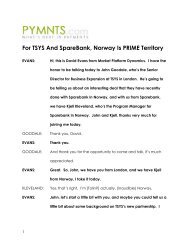Interchange Fees: The Economics and Regulations of What
Interchange Fees: The Economics and Regulations of What
Interchange Fees: The Economics and Regulations of What
- No tags were found...
You also want an ePaper? Increase the reach of your titles
YUMPU automatically turns print PDFs into web optimized ePapers that Google loves.
10 INTERCHANGE FEESmaximizing price structure for the system—the price structure that gets <strong>and</strong> keeps both sets <strong>of</strong>customers on board <strong>and</strong> permits both issuers <strong>and</strong> acquirers to be pr<strong>of</strong>itable—is one that obtainsthe bulk <strong>of</strong> the revenue from the merchant side <strong>of</strong> the business.<strong>The</strong>se unitary systems instituted these pricing schemes in their early years, when they wouldappear to have had little market power. We think it is fair to conclude that the “competitive”—certainlyin the sense <strong>of</strong> non-collusive <strong>and</strong> non-monopolistic—pricing structure for payment cards is(or at least was for some time) one in which merchants pay a relatively high transaction price <strong>and</strong>cardholders pay zero or possibly slightly negative transaction prices plus modest fixed fees, <strong>and</strong> inwhich the bulk <strong>of</strong> the pr<strong>of</strong>its, loosely speaking, thus flow from the merchant side. Being the competitivepricing structure does not necessarily mean that it is socially optimal, however, <strong>and</strong> it is tothat issue we turn next.C. Pr<strong>of</strong>it versus WelfareHow do prices charged in two-sided markets compare with socially optimal prices? Most theoreticalanalysis <strong>of</strong> this question considers a single firm with some market power (in other words,it faces dem<strong>and</strong> curves that slope down—though they may be highly price-elastic) selling to twocustomer groups in an otherwise perfectly competitive economy. Under these assumptions it isclear that the price level will be too high because <strong>of</strong> the exercise <strong>of</strong> market power—a conclusionthat, <strong>of</strong> course, applies to most firms in real economies.In fact, the monopoly pricing problem is even more serious than usual: Even if marginalcosts are constant <strong>and</strong> there are no fixed costs, the first-best social optimum requires settingprices that do not cover total cost, just as is the case with natural monopoly. 28 <strong>The</strong> intuition isstraightforward. In an ordinary, one-sided market under the usual assumptions, buyers’ willingnessto pay for incremental units <strong>of</strong> output provides a measure <strong>of</strong> the social value <strong>of</strong> that output.Thus the social optimum in such markets occurs at the output level at which price is equal tomarginal cost, since at lower levels <strong>of</strong> output buyers are willing to pay more than marginal costfor incremental output, while at higher levels <strong>of</strong> output they are willing to pay less than marginalcost. In a two-sided market, however, increases in output on side A <strong>of</strong> the market providepositive benefits to buyers on side B that are not reflected in the side A dem<strong>and</strong> curve. Thus, ifprice equals marginal cost to customer group A, it is nonetheless socially beneficial to increaseoutput to A because <strong>of</strong> the (externality) benefits that would thereby be conferred on members<strong>of</strong> group B.<strong>What</strong> about price structure? In general single-firm models <strong>of</strong> two-sided markets in otherwiseperfectly competitive economies, one can compare the conditions defining pr<strong>of</strong>it- maximizing28This is explicitly shown in Armstrong (2004) <strong>and</strong> Bolt <strong>and</strong> Tieman (2004b). It is implicit in Rochet <strong>and</strong> Tirole (2003b), sincetheir analysis <strong>of</strong> socially optimal pricing imposes the binding constraint that the firm just break even.








